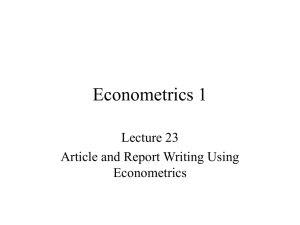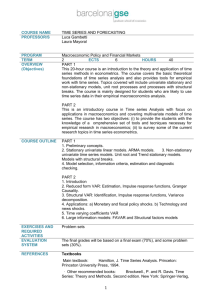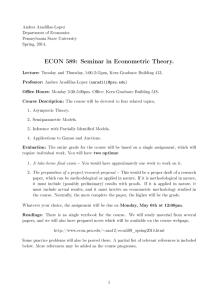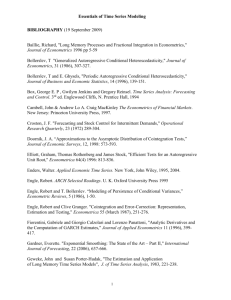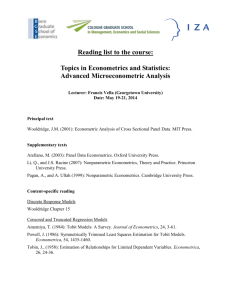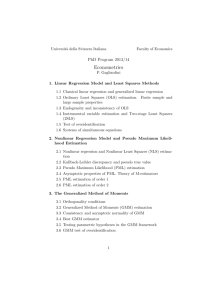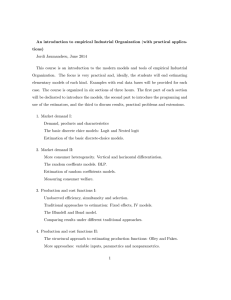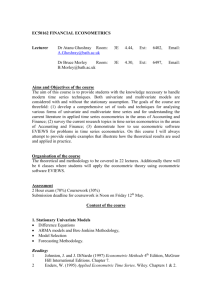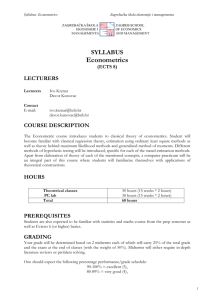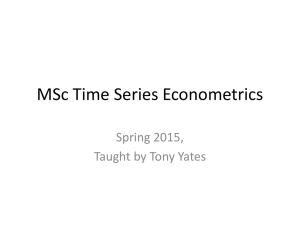Syllabus
advertisement
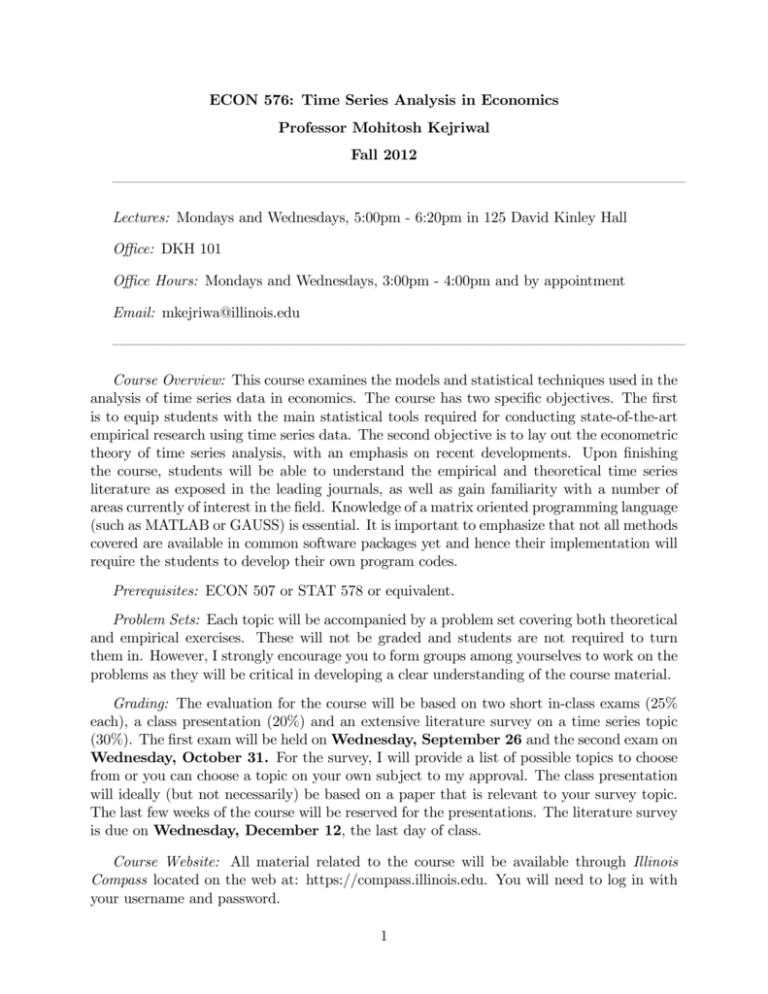
ECON 576: Time Series Analysis in Economics Professor Mohitosh Kejriwal Fall 2012 ——————————————————————————————————————— Lectures: Mondays and Wednesdays, 5:00pm - 6:20pm in 125 David Kinley Hall O¢ ce: DKH 101 O¢ ce Hours: Mondays and Wednesdays, 3:00pm - 4:00pm and by appointment Email: mkejriwa@illinois.edu ——————————————————————————————————————— Course Overview: This course examines the models and statistical techniques used in the analysis of time series data in economics. The course has two speci…c objectives. The …rst is to equip students with the main statistical tools required for conducting state-of-the-art empirical research using time series data. The second objective is to lay out the econometric theory of time series analysis, with an emphasis on recent developments. Upon …nishing the course, students will be able to understand the empirical and theoretical time series literature as exposed in the leading journals, as well as gain familiarity with a number of areas currently of interest in the …eld. Knowledge of a matrix oriented programming language (such as MATLAB or GAUSS) is essential. It is important to emphasize that not all methods covered are available in common software packages yet and hence their implementation will require the students to develop their own program codes. Prerequisites: ECON 507 or STAT 578 or equivalent. Problem Sets: Each topic will be accompanied by a problem set covering both theoretical and empirical exercises. These will not be graded and students are not required to turn them in. However, I strongly encourage you to form groups among yourselves to work on the problems as they will be critical in developing a clear understanding of the course material. Grading: The evaluation for the course will be based on two short in-class exams (25% each), a class presentation (20%) and an extensive literature survey on a time series topic (30%). The …rst exam will be held on Wednesday, September 26 and the second exam on Wednesday, October 31. For the survey, I will provide a list of possible topics to choose from or you can choose a topic on your own subject to my approval. The class presentation will ideally (but not necessarily) be based on a paper that is relevant to your survey topic. The last few weeks of the course will be reserved for the presentations. The literature survey is due on Wednesday, December 12, the last day of class. Course Website: All material related to the course will be available through Illinois Compass located on the web at: https://compass.illinois.edu. You will need to log in with your username and password. 1 Textbooks and Lecture Notes: The required textbook for the course is Hamilton, J.D. (1994), Time Series Analysis, Princeton University Press. Two other books that are more application oriented and will often be referred to are: (1) Enders, W. (2010), Applied Econometric Time Series, Third Edition, Wiley. (2) Lütkepohl, H. & Krätzig, M. (2004), Applied Time Series Econometrics, Cambridge University Press. I will additionally provide a set of lecture notes for each topic covered in class. Other Suggested References: 1. Brockwell, P.J. & Davis, R.A., Time Series: Theory and Methods, Springer. 2. Davidson, J., Stochastic Limit Theory, Oxford University Press. 3. Davidson, R. & MacKinnon, J.G., Econometric Theory and Methods, Oxford University Press. 4. Harvey, A.C., Forecasting, Structural Time Series Models and the Kalman Filter, Cambridge University Press. 5. Lütkepohl, H., New Introduction to Multiple Time Series Analysis, Springer. 6. Tsay, R.S., Analysis of Financial Time Series, Third Edition, Wiley. 7. White, H., Asymptotic Theory for Econometricians, Academic Press. Emergency: In the event of a major campus emergency, course requirements, deadlines and grading percentages are subject to changes that may be necessitated by a revised semester calendar or other circumstances. Course Outline and Suggested Readings [* denotes primary reading] Part I: Stationary Time Series Models Univariate Time Series: Concepts of stationarity and ergodicity, ARMA processes, principles of forecasting, estimation in the time domain. References: 1. *Hamilton, Ch 3-5. 2. Enders, Ch 2. 3. Lütkepohl & Krätzig, Ch 2. Multivariate Time Series: identi…cation, estimation and inference using vector autoregressive processes (VARs), causality tests, impulse response function, variance decomposition. 2 References: 1. *Hamilton, Ch 10-11. 2. Enders, Ch 5. 3. *Lütkepohl & Krätzig, Ch 3-4. 4. Blanchard, O.J. & Quah, D. (1989), The Dynamic E¤ects of Aggregate Demand and Supply Disturbances, American Economic Review 79, 655-673. 5. Cooley, T. & Dwyer, M. (1998), Business Cycle Analysis without Much Theory: a Look at Structural VARs, Journal of Econometrics 83, 57-88. 6. Granger, C.W.J. (1969), Investigating Causal Relations by Econometric Models and Cross-spectral Methods, Econometrica 37, 424-438. 7. Shapiro, M. & Watson, M. (1988), Sources of Business Cycle Fluctuations, NBER Macroeconomics Annual 3, 111-147. 8. *Stock, J.H. & Watson, M.W. (1999), Business Cycle Fluctuations in U.S. Macroeconomic Time Series, in Handbook of Macroeconomics Vol. 1a, 3-64. 9. *Sims, C.A. (1980), Macroeconomics and Reality, Econometrica 48, 1-48. Part II: Nonstationary Time Series Models The Functional Central Limit Theorem References: 1. Hamilton, Ch 17. 2. Davidson, J. (1994), Stochastic Limit Theory, Oxford University Press. Trends and Unit Roots: Estimation with deterministic time trends, comparison of trend stationary and unit root processes, approaches to testing for a unit root. 1. *Hamilton, Ch 17. 2. Enders, Ch 4. 3. Lütkepohl & Krätzig, Ch 2. 4. *Campbell, J. Y. & Perron, P. (1991), Pitfalls and Opportunities: What Macroeconomists should know about Unit Roots, NBER Macroeconomic Annual 6, 141-201. 3 5. Dickey, D.A. & Fuller, W.A. (1979), Distribution of the Estimators for Autoregressive Time Series With a Unit Root, Journal of the American Statistical Association 74, 427-431. 6. *Elliott, G., Rothenberg, T.J. & Stock, J.H., (1996), E¢ cient Tests for an Autoregressive Unit Root, Econometrica 64, 813-836. 7. *Nelson, C.R. & Plosser, C.I. (1982), Trends and Random Walks in Macroeconomic Time Series, Journal of Monetary Economics 139-162. 8. *Ng, S. & Perron, P. (2001), Lag Length Selection and the Construction of Unit Root Tests with Good Size and Power, Econometrica 6, 1519-1554. 9. Stock, J.H. (1994), Unit Roots, Structural Breaks and Trends, Handbook of Econometrics vol IV, chapter 46. Cointegration and Error Correction: Estimation of vector error correction models, impulse response analysis, forecasting in cointegrated systems, testing for cointegrating rank. References: 1. *Hamilton, Ch 18-20. 2. Enders, Ch 6. 3. *Lütkepohl & Krätzig, Ch 3-4. 4. Elliott, G. (1998), The Robustness of E¢ cient Cointegration Estimators when Regressors Almost Have Unit Roots, Econometrica 66, 149-158. 5. *Engle, Robert F. & Granger, C.W.J. (1987), Co-Integration and Error Correction: Representation, Estimation and Testing, Econometrica 55, 251-276. 6. Haug, A. (1996), Tests for Cointegration: A Monte Carlo Comparison, Journal of Econometrics 71, 89-115. 7. Jansson, M and Moreira, M. (2006), Optimal Inference in Regression Models with Nearly Integrated Regressors, Econometrica 74, 681-714. 8. King, R. G., Plosser, C.I., Stock, J.H. & Watson, M.W. (1991), Stochastic Trends and Economic Fluctuations, American Economic Review 81, 819-840. 9. *Watson, M (1994), Vector Autoregressions and Cointegration, Handbook of Econometrics vol IV, chapter 47. 4 Part III: Selected Topics Structural Breaks: detection and estimation of structural breaks in time series data, interplay between structural change and unit roots, forecasting in the potential presence of breaks. References: 1. *Enders, Ch 4. 2. *Andrews, D.W.K. (1993), Tests for parameter instability and structural change with unknown change point, Econometrica 61, 821-856. 3. Bai, J. (1997), Estimation of a change point in multiple regression models, Review of Economics and Statistics 79, 551-563. 4. Bai, J., Lumsdaine, R.L. & Stock, J.H. (1998), Testing for and Dating Common Breaks in Multivariate Time Series, Review of Economic Studies 63, 395-432. 5. *Bai, J. & Perron, P. (1998), Estimating and Testing Linear Models with Multiple Structural Changes, Econometrica 66, 47-78. 6. Hansen, B. (2001), The New Econometrics of Structural Change: Dating Changes in U.S. Labor Productivity, Journal of Economic Perspectives 15, 117-128. 7. *Perron, P. (2006), Dealing with structural breaks, in Palgrave Handbook of Econometrics, Palgrave Macmillan, 278-352. 8. Stock, J.H. & Watson, M.W. (1996), Evidence on Structural Instability in Macroeconomic Time Series Relations, Journal of Business & Economic Statistics 14, 11-30. Nonlinearity and Volatility Modeling: Estimation, inference and prediction using ARCH, GARCH and stochastic volatility models, comparison of forecast performance using alternative models, predictive regression analysis, introduction to multivariate GARCH models, estimation of some selected nonlinear models such as threshold and smooth transition models, testing for linearity. References: 1. Andersen, T.G. & Bollerslev, T. (1998), Answering the skeptics: yes, standard volatility models provide accurate forecasts, International Economic Review 39, 885-905. 2. Bauwens, L., Laurent, S. & Rombouts, J.V.K. (2006), Multivariate GARCH models: a survey, Journal of Applied Econometrics 21, 79-109. 3. *Bollerslev, T. (1986), Generalized autoregressive conditional heteroskedasticity, Journal of Econometrics 31, 307-327. 5 4. *Engle, R.F. (1982), Autoregressive conditional heteroskedasticity with estimates of the variance of UK in‡ation, Econometrica 50, 987-1007. 5. *Hansen, B. (1999), Testing for linearity, Journal of Economic Surveys 13, 551-576. 6. Hansen, P. & Lunde, A. (2005), A forecast comparison of volatility models: does anything beat a GARCH(1,1)?, Journal of Applied Econometrics 20, 873-889. 7. Nelson, D. (1991), Conditional heteroskedasticity in asset returns: a new approach, Econometrica 59, 347-370. 8. Teräsvirta, T. (2009), An introduction to univariate GARCH models, in Handbook of Financial Time Series, Springer. 9. *Terasvirta, T., Tjostheim, D. & Granger, C.W.J. (1994), Aspects of Modelling Nonlinear Time Series, Handbook of Econometrics vol IV, chapter 48. 10. Tsay, R.S. (2010), Analysis of Financial Time Series, Third Edition, Wiley (Ch 3). 11. *Zivot, E. (2009), Practical issues in the analysis of univariate GARCH models, in Handbook of Financial Time Series, Springer. Unobserved Components Models: state space modeling, Kalman Filter, maximum likelihood estimation and the prediction error decomposition. 1. *Hamilton, Ch 13, 22. 2. *Hamilton, J.D. (1989), A New Approach to the economic Analysis of Nonstationary Time Series and the Business Cycle, Econometrica 57, 357-384. 3. *Harvey, A.C. (1989), Forecasting, Structural Time Series Models and the Kalman Filter, Cambridge University Press (Ch 3-5). 4. Durbin, J. & Koopman, S.J. (1997), Monte Carlo Maximum Likelihood Estimation for Non-Gaussian State Space Models, Biometrika 84, 669-684. 5. Kitagawa, G. (1987), Non-Gaussian State Space Modelling of Non-Stationary Time Series with discussion, Journal of the American Statistical Association 82, 1032-1063. 6. Perron, P & Wada, T. (2009), Let’s Take a Break: Trends and Cycles in US Real GDP, Journal of Monetary Economics 56, 749-765. 6
